


 |
March 6, 2016: Dallas Blooms! (The Dallas Arboretum) |
 |
January 29, 2016: Frank and Joe at the Dallas Arboretum |
 |
Return to the Index for 2016 |
On Friday, February 26, Fred and I headed down to San Antonio, accepting an invitation to come visit Prudence, Ron and Guy for the weekend. Karl and Nancy would also be there, so it should be a nice visit. We decided to take Fred's new Elantra GT so that Prudence and Ron could see it. Little did we know that would be a bad decision.
Getting to the Ruckman's House in San Antonio
You have probably seen an album page where we visit San Antonio, but in case you haven't, I want to show you the route to San Antonio from Dallas and where Prudence and Ron and Guy are located.
On the maps below, you can see the route to the Ruckmans' house. It is an easy matter to simply hop on I-35E from the Tollway in Dallas and take that highway all the way south through Austin to San Antonio. This 280-mile trip routinely takes about 4.5 hours. In San Antonio, we continue to follow I-35 into the city, eventually exiting onto San Pedro Avenue. We take that north about two miles, and either hang a left on Ashby and a right on Breeden or just a left on French to get to the Ruckmans' house on the northeast corner of Breeden and French.
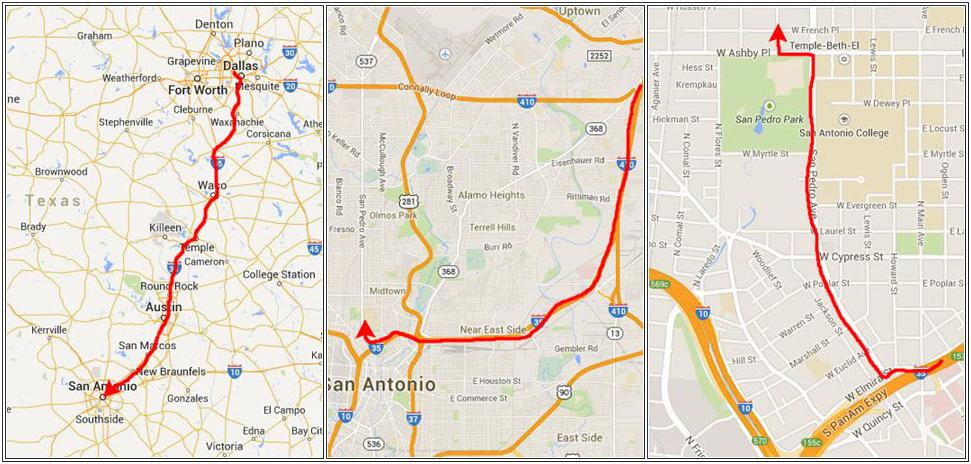 |
In case you have not seen them, I have put below first an aerial view of the Ruckmans' house (it is the house on the corner and the garage/apartment building north of it where Guy lives) and a front view of the house (taken in 2010).
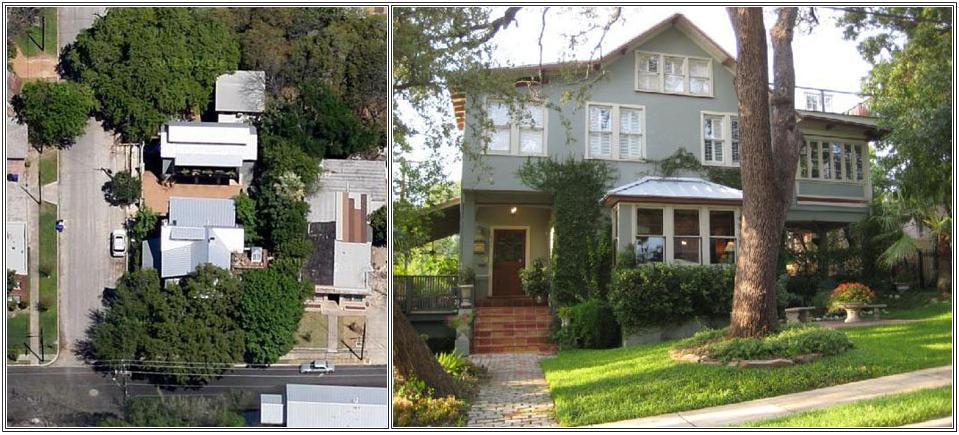 |
We did the usual things during our visit- stuff around the house, eating out, eating in, visiting with Nancy and Karl- but Fred, Guy and I also made a trip to the San Antonio Botanical Garden and all of us made a trip to the Sunday market down at the site of the old Pearl Brewery on the north end of the Riverwalk. We took pictures at the market and at the Botanical Garden, and then a couple of others that we wished we hadn't had the opportunity to take.
The San Antonio Botanical Gardens
On Sunday morning, Guy, Fred and I made a trip over to the San Antonio Botanical Garden. It was a pretty day, and a nice one to be in the gardens.
|
In 1970, voters approved $265,000 in bonds for the Garden. This money, along with a grant awarded five years later by the Ewing Halsell Foundation, other contributions from organizations and individuals, and a significant grant from the Economic Development Administration helped pay for the project. Groundbreaking ceremonies were held on July 21, 1976. The official opening of the San Antonio Botanical Garden was May 3, 1980.
One of the first things Guy did when he moved to San Antonio in July was to get a membership at the Botanical Garden so he can come here frequently and walk. Apparently, he does this at least a couple of times a week. If I lived nearer to the Dallas Arboretum, I'd probably go more frequently as well.
|
Getting to the gardens is just a fifteen-minute trip from Ruckman Haus, and I knew the way quite well. I didn't put a distance scale on the map at right, but the whole trip is a little less than three miles.
I think there are a number of reasons why Guy comes to the gardens frequently. They, like the Dallas Arboretum, are not only a delight to the eyes, but provide rest for the soul as well. That rest is something Guy treasures, and something we should all get more of.
|
We came in through the entry (where a display announced the exhibit of sculpture) and walked up into the gardens. There are always some nice potted arrangements by the Sullivan Carriage House, and there is a ramp that goes from the Carriage house up along a wall where all kinds of succulents grow and into the gardens.
I took a couple of pictures on our way up the ramp, and there are clickable thumbnails below for them:
 Click Thumbnail to View |
Today, we visited some areas of the garden we don't visit frequently, and perhaps it might be useful if I showed you a diagram of the gardens on which I can note some of these areas.
|
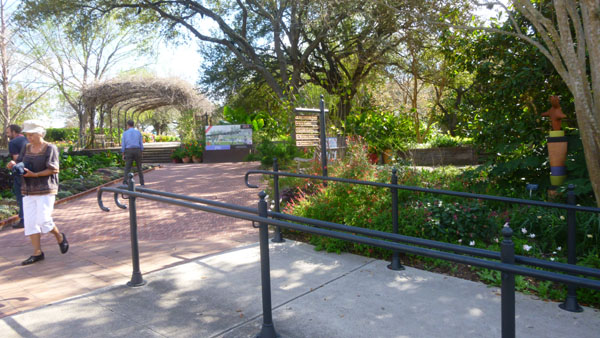 |
I stopped ahead of the wisteria arbor to take a look back towards the carriage house. The view was really neat, but I couldn't get the entry pavilion, the rose garden, and the old-fashioned garden, so instead I took four pictures and put 'em together into a panorama, which can best be viewed in the scrollable window below:
It was a beautiful early afternoon here in the gardens, and we spent quite a bit of time just wandering around the plaza where the old-fashioned garden is- just below the wisteria arbor.
|
|
Here are a few of the photos that we took at this point in our stroll through the garden:
 (Click Thumbnail to View) |
We walked through the wisteria arbor and out onto Fountain Plaza- the centerpiece of which is a long water feature that begins with a fountain on its north end. It is always a great place for pictures.
|
We walked into the Sensory Garden for a bit; here there are plants with distinctive smells and feel, and there are sculptures large and small designed for people to touch and experience.
|
|
From the Sensory Garden, we walked the short distance to the first building in the group of buildings that make up the prize-winning Lucile Halsell Conservatory, which opened in February 1988. Argentinean-American Emilio Ambasz, the designer of the futuristic glass project, has a world-wide reputation. This conservatory was the first of his projects ever built and his revolutionary design has been emulated and copied at several other locations.
|
This project presents many new ideas on conservatory design. Most conservatories have all of their display areas connected by hallways or smaller rooms. By using the mild climate of San Antonio, designer Ambasz and local architect Jones Kell have the visitor enter an open-air courtyard; the various "greenhouses" are separate and only accessible via the courtyard. So the area can actually be viewed as five separate conservatories built around the courtyard. Not only does the climate help make this design work, but the arcades (overhead covered areas) also provide protection from the elements.
Just through the doors in the picture at right, you pass through a short passageway that has display windows on either side. Inside both these windows are parts of the Botanical Garden's orchid collection.
A unique design feature is the subterranean effect of the Conservatory. As visitors enter the front, they actually go underground through a tunnel. At the entrance, the project is cut into the original grade by three feet, with soil over the entryway. The Palm House is cut 20 feet into the earth, with the original exterior grade surface remaining unchanged.
Basically, all of the rooms are sunken in the ground and have a glass roof at least 18 feet above the floor level. The largest glasshouse, the palm pavilion, soars 65 feet at its highest point. The fern room is actually 23 feet below the surface. This design is successful in San Antonio because of the quality and quantity of sunlight. The sun is almost overhead in the summer and only dips 22 degrees above the horizon at its lowest point in the winter. Another of the rooms is the Kleberg Desert Pavilion, and since Fred is interest in cactus and succulents, we always take a walk through this room.
Another unique feature is that only the glass roofs protrude above the earth’s surface. All mechanical rooms, offices, and backup areas are underground, allowing for the very clean, uncluttered look of the landscape.
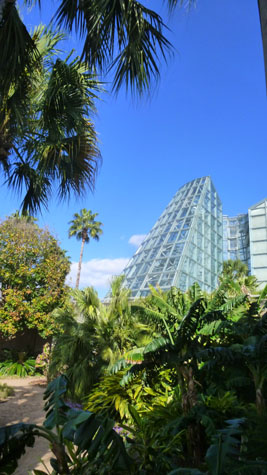 The Conservatory |
(Picture at left) From the below-grade interior courtyard, you can look up and around you and see the other buildings in the conservatory. In the tall palm pavilion, the walkway exits to the outside at the top.
|
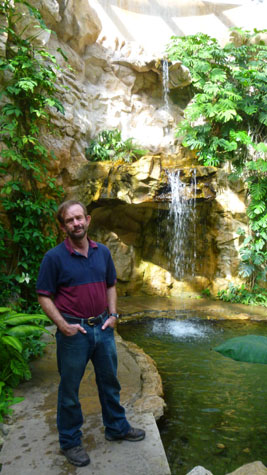 In One of the Greenhouses |
Coming out of the Palm and Cycad House, we took the walkway over past The Overlook- the highest point in the Botanical Gardens. On the walkway just below it, I took a series of pictures to put together into a panoramic view:
 |
We continued walking along the trail below the overlook, heading over to the Texas Native Trail entrance. At one point, we stopped under the trees to look out over the Botanical Garden. Here are more of the pictures we took along the walkway:
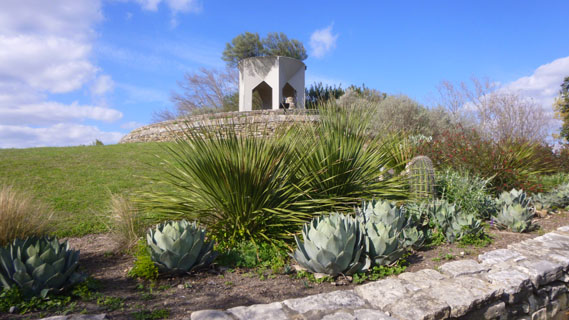 The Overlook Tower This building is a place where visitors can look out over the entire botanical garden in all directions. I should go up there sometime and make a 360° panorama. |
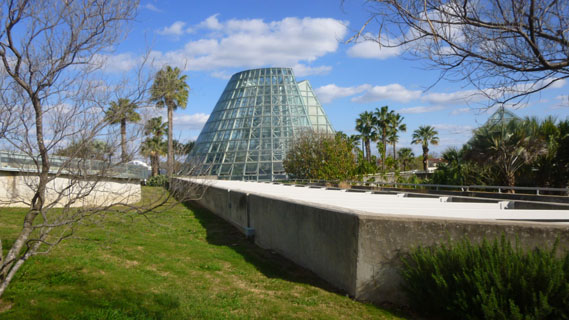 The Conservatory This view, taken from the walkway below the Overlook Tower, takes in the Palm and Cycad House and other buildings in the Lucile Halsell Conservatory. |
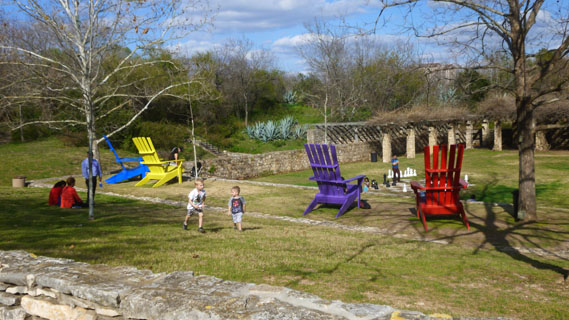 The Amphitheatre When not in use for some event, the amphitheatre is a great place for picnics or for kids to play. |
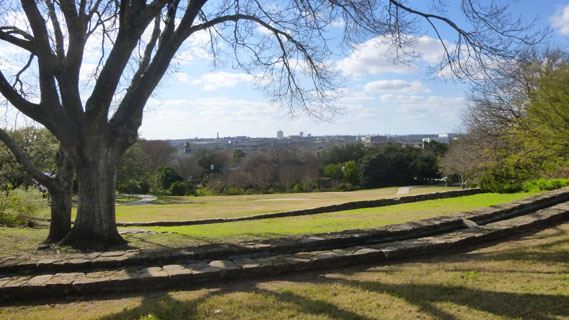 The View West This view, taken from the walkway below the Overlook Tower, looks across north San Antonio towards Ruckman Haus. |
Just before reaching the entrance to the Texas Native Trail, we passed an outdoor art installation, and here are a couple of pictures of it:
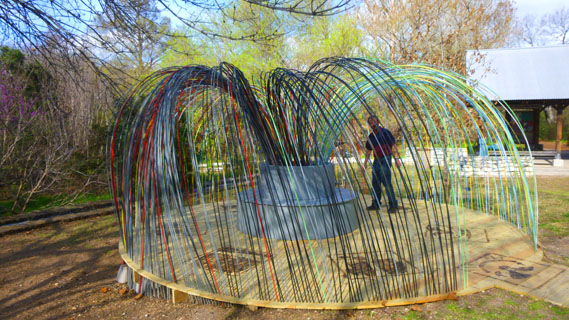 |
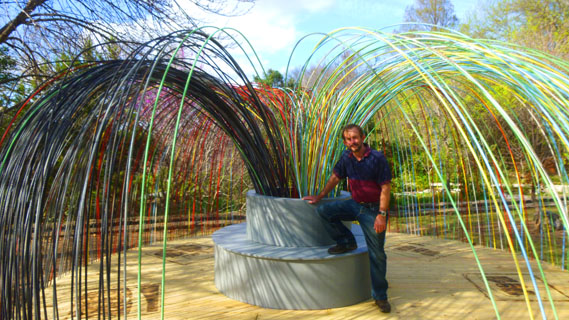 |
We walked all around the lake that is at the center of the East Texas Pineywoods area of the botanical garden, stopping, as we have before, at the Log Cabin. Right in front of it there is a dispenser where a quarter will buy you a handful of nuggets to feed to the ducks that occupy the pond.
|
There is a story that Mrs. Schumacher had finished baking bread one day and placed her loaves near the window to cool. Suddenly she looked up and saw an Indian standing there holding a knife and motioning to her to cut some of it for him. She did, and he soon left, causing no disturbance or harm. Mr. Schumacher then planted a dense, thorny bois d’arc (commonly known as Osage Orange) hedge along the edge of the property to provide protection from intruders.
The simple plantings of an early German homestead complete the setting of the Schumacher House. To reach the Botanical Garden, the structure was disassembled, indexed, and re-assembled on site. The restoration of the Schumacher House by the San Antonio Botanical Garden Society won a 2006 preservation award from the San Antonio Conservation Society.
We continued on back towards the entrance, passing through the Rose Garden the Rose Garden on our way.
The "Wings of the City" Exhibition at the San Antonio Botanical Garden
The current exhibition in the Botanical Garden is a series of sculptures by Mexican artist Jorge Marin. (The information about Marin and his sculptures was copied verbatim from the sign at the entrance to the gardens.)
|
| "With over 25 years of artisticwork, he has successfully entered into Mexico's artistic scene and has become a representative of figurative international sculpture using bronze as a particular seal. He has more than 250 exhibitions around the world. Some of his sculptures are in cities like Berlin, Tel Aviv, Mexico City, Long Beach, Sarasota, Los Angeles and Shanghai." |
| "Today the public space hasn't been a place limited to the funcionality. The architecture and the art converge with the space to recreate it, to generate new experiences and create a different experience in the visitor. The exhibition aims the visitor transit in the place, creating a different experience. Beyond to limitate the space in sight, the purpose of his exhibition is to awake different senses in the viewer." |
I probably should have taken pictures of each of the sculpture's plaques, for some of them had more information than just the title of the piece, but I didn't. So the best I can do is to show you the sculpture pieces and simply the title of each:
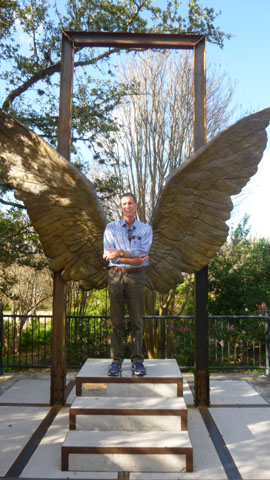 Alas de Mexico |
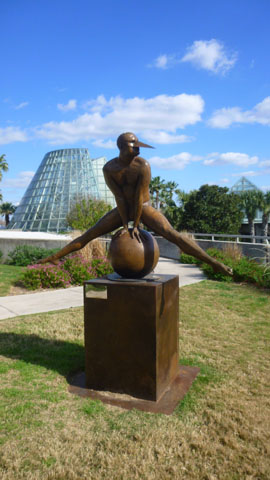 Split Monumental |
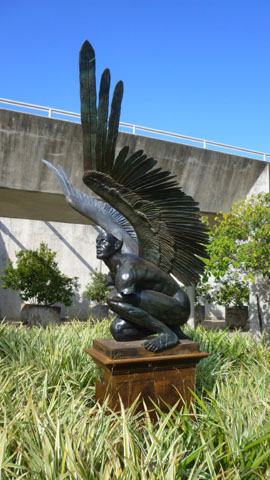 El Tiempo |
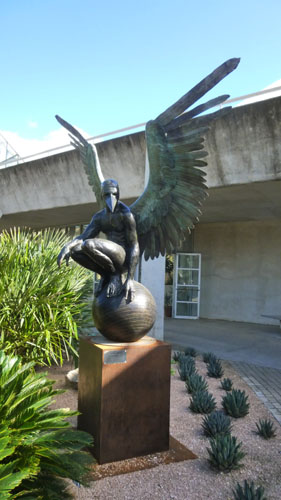 Persilas Monumental |
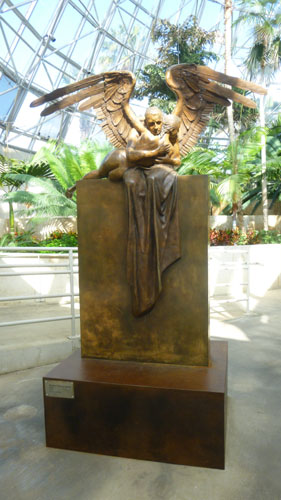 Abrazo Monumental |
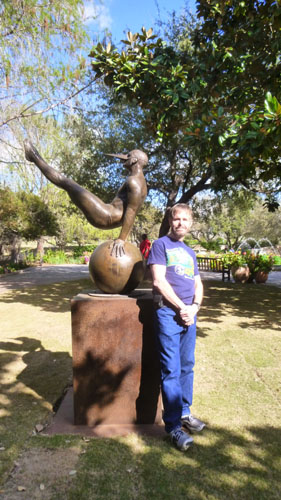 Equilibrista 90 |
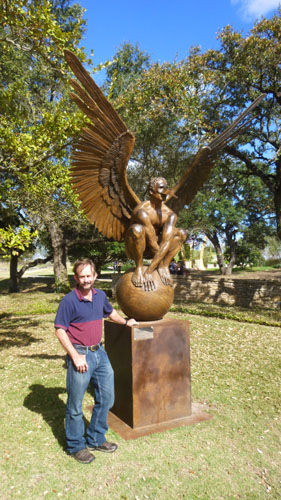 Archivaldo |
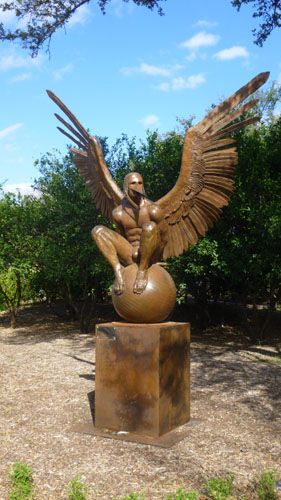 Bernardo Oriental Monumental |
 Persilas Monumental |
Although the artist seemed to have a definite theme, and I thought some of the sculptures were just variations on a theme, but that did not detract from their beauty.
The Farmers' Market at the Pearl Brewery
On Saturday and Sunday, the Pearl Brewery area at the north end of the Museum Reach section of the San Antonio Riverwalk hosts a farmers' market. There are usually thirty or forty stalls selling flowers and vegetables as well as various prepared food items. We have been there before, but today Prudence, Ron, Guy, Fred, Jax and I went over for lunch. All the shops are open both days as well, so it is a great time to shop, eat or just people watch. We took three good pictures today, and here they are:
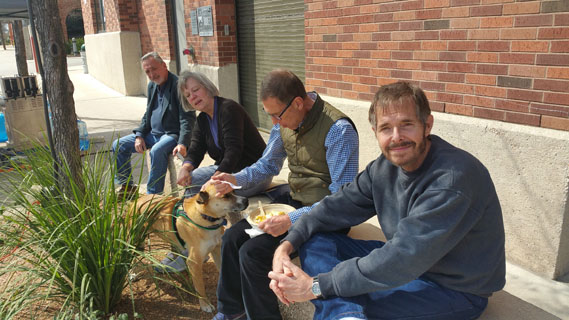 |
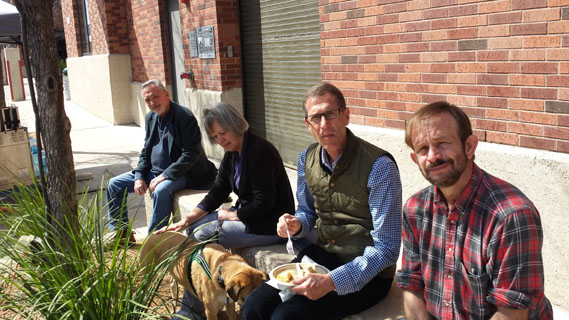 |
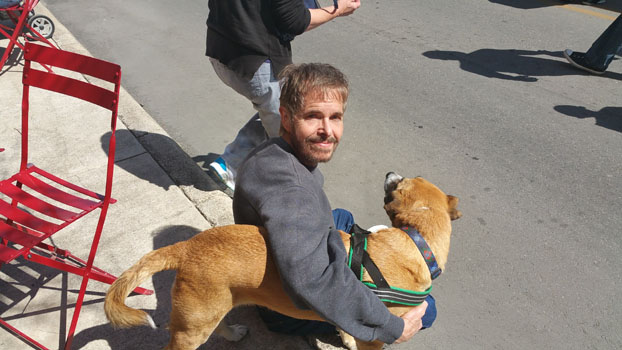 |
An Unfortunate Event
On Saturday, Fred's new car was parked alongside Ruckman Haus on Breeden Street. On our many trips down here, I have parked my own car in about the same place. I have also parked it in front on French Street. Sometimes, I have pulled it into the garage apron behind the house, and when all three sheltered spaces are full just parked it near the back of the house. We asked about doing that this evening, but Guy sometimes has a problem getting out of his own space when there is another car there, so we left it on Breeden.
Fred and I were in the Luxembourg Room, at the Breeden end of the house, and just before midnight we heard much shouting and commotion in the street below. With no window where we could look down, we just listened for a minute. I suppose I might have gone out on the balcony to look, but I didn't. After less than thirty seconds there was more shouting, a vehicle door slamming and a squealing of tires. Immediately there was a loud crash and the sound of a vehicle zooming away. The crash sounded very close to the house, and so we threw on some clothes, ran downstairs and out the front door to Breeden. There were three vehicles parked there, and Fred's new car was in the middle of them. Whoever had been in the vehicle had left the scene, but as we feared, that vehicle had collided with Fred's car, destroying the left rear part of the car, shoving it into the curb (thus damaging the right rear wheel) and also shoving it forward into the vehicle in front, destroying the front license plate holder.
Of course the police came, having already been called by a witness who, unfortunately, could not get the license number of the vehicle that left the scene. We cleaned up the car pieces from the road and saved them for insurance. We filled out the police report and called State Farm to get the repair process underway. Finally, the next morning we took two pictures of the car before pulling it into the parking area behind Prudence's house (and we had to get a crowbar and bend the metal away from the tire to drive the car).
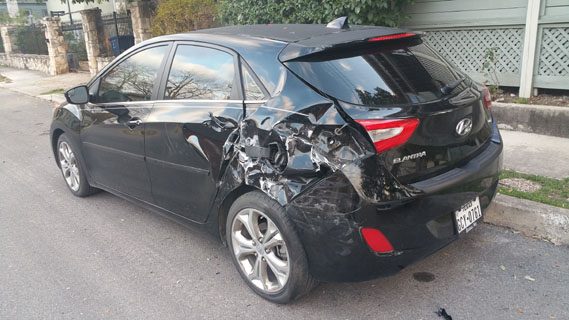 |
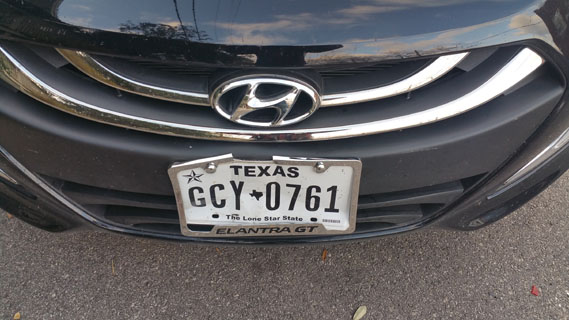 |
Postscript:
We did get the claim filed and made repair arrangements before leaving for home on Monday. The car was quite drivable after our work with the crowbar, and we took it to my house where I got my own car and then the two of us drove the vehicles up to Huffines Hyundai in Plano. There, we dropped it off, filled out some paperwork, and I took Fred on home to Van Alstyne. The car was there for a month, during which time we made one of our trips to Florida. A few days after we returned, Fred's car was ready. Yes, he had to pay a $500 deductible, but the rest of the repair cost, some $8500, was paid by State Farm. I have to admit, that after a rattle was fixed on a return visit, it would be very hard to tell that his car had ever been damaged. He even got new license plates so he wouldn't have to drive with bent ones. A bad experience, but it is now behind us.
Other than the experience with the car, though, our visit to see Ron, Prudence and Guy was very enjoyable- as all our visits to San Antonio seem to be. Fred won't be bringing his car down here again, though, I suspect.
You can use the links below to continue to another photo album page.
 |
March 6, 2016: Dallas Blooms! (The Dallas Arboretum) |
 |
January 29, 2016: Frank and Joe at the Dallas Arboretum |
 |
Return to the Index for 2016 |